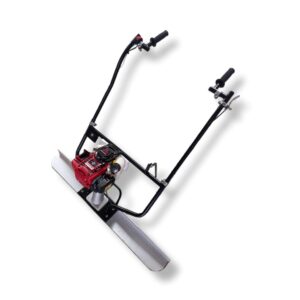Whether you’re a construction professional or a DIY enthusiast, achieving a smooth and polished finish when working with concrete is crucial. It not only enhances the aesthetic appeal of a surface but also its durability.
However, obtaining this smooth finish isn’t as simple as pouring and letting the concrete set. The secret is in the art of concrete finishing, with the right tools and equipment playing a significant role in the process.
Understanding Concrete Finishing Equipment
When it comes to concrete finishing, there are several types of equipment that are indispensable to the process. Among the most commonly used are power trowels, screeds, and floats.
Power trowels, also known as power floats, are used to create a smooth, hard and polished surface. They are generally used on large surface areas where a hand trowel is impractical.
Screeds are long, straight tubes or boards used to level and smooth the top layer of the concrete right after it has been poured. They help ensure the concrete surface is flat and uniform.
Concrete floats come into play after screeding. These tools are used to further smooth the surface, pushing down the aggregate and bringing the ‘cream’, or cement paste, to the top, aiding in the creation of a polished finish.
The Process of Concrete Finishing
The process of concrete finishing starts right after the concrete has been poured. It begins with screeding to level out the wet concrete. Once the concrete has been screeded, floating is the next step. The concrete is smoothed out using a float, which pushes down the aggregate and brings the cement paste to the top.
After floating, a power trowel is used to compact the concrete and create a smooth, polished finish. The timing of these steps is critical, as working the concrete too soon or too late can lead to problems such as cracking or a lack of polish.
Impact of Equipment on Final Results
The quality of your concrete finishing equipment can greatly affect the final result. High-quality tools can help ensure a smooth, even, and polished surface. Furthermore, equipment designed for the type and scale of your project will lead to a more efficient and successful process, saving both time and resources.
Equipment Selection Criteria
Choosing the right concrete finishing equipment relies on several factors. Firstly, the type of surface you’re working on and the size of the project are important considerations. Large scale projects may require the use of power trowels for efficiency and consistency, while a small DIY job could be completed with a hand float and screed.
The desired finish is also a key consideration. For a very smooth, polished finish, a power trowel is often necessary. On the other hand, non-slip surfaces may only require screeding and floating.
Maintenance of Concrete Finishing Equipment
Just like any other tool, proper maintenance of concrete finishing equipment is key for optimal performance and longevity. Regular cleaning after use is crucial to remove concrete residue that can harden and damage the tools. Periodic checks for wear and tear, especially on the blades of power trowels, will also ensure your equipment remains in good working order.
Future Trends in Concrete Finishing Equipment
Advancements in technology are revolutionising the concrete finishing industry. Automated equipment and remote-controlled power trowels are becoming more common, offering increased efficiency, accuracy and safety. Staying up-to-date with these developments is essential for those working in construction.




